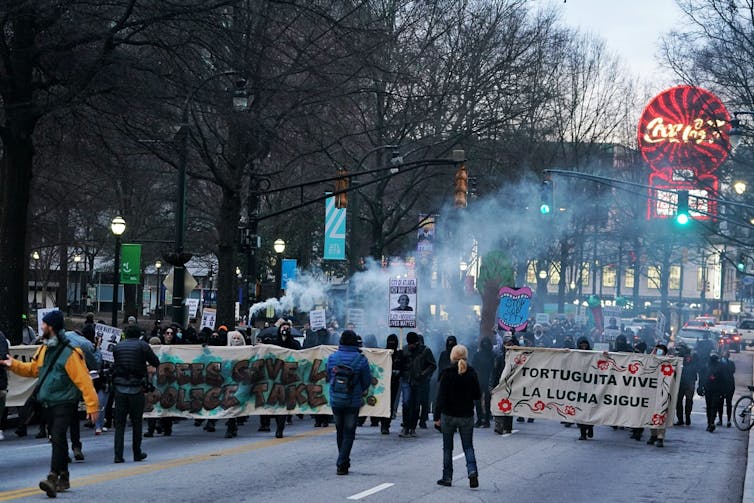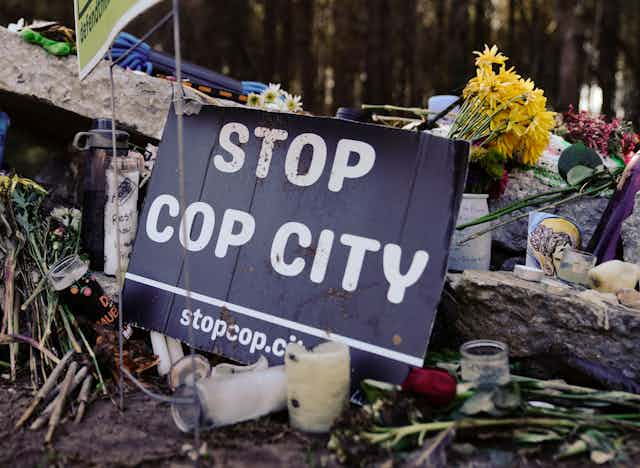Manuel Terán was one of a few dozen environmentalist activists who joined a protest nearly three years ago against the clearing of about 300 acres of woodlands near Atlanta to construct a proposed police and firefighter training center that critics fear would lead to greater “police militirization.”
Since 2021, some of the activists that include civil rights advocates and Indigenous tribes have called themselves “forest defenders” and rallied under the mantra of “Stop Cop City” to block construction workers by sitting in trees and, in some cases, setting fires and damaging construction vehicles.
Local police have responded in force with batons and riot shields to subdue demonstrators who on one march in November 2023 were armed with tree saplings that they wanted to plant in cleared sections of the South River Forest.
But those protests turned deadly on Jan. 18, 2023, when Terán was shot and killed during a police raid at one of the makeshift camps set up by activists.
Local police claim Terán fired the first shot. But some activists dispute the official version and argue that Terán was surrendering when he was shot 57 times by six different police officers.
Either way, one thing is indisputable: Terán was the first environmental activist to be killed by police in U.S. history.
A little more than a year later, his death has brought renewed questions about the dangerousness of environmental extremism.
The threat of ecoterrorism
Since Terán’s death, multiple waves of raids by police have largely cleared the area of protesters.
More than 40 Stop Cop City movement protesters face domestic terrorism charges and another 61 protesters face Georgia racketeering charges for actions related to their involvement in the movement.
Those criminal actions, exceptions to the majority of nonviolent demonstrations organized by environmental activists, included damaging buildings, setting fires to police cars, and vandalism.
Although the radical environmental movement did not emerge in the U.S. until the 1970s, it has been considered by the FBI to be a domestic terrorist threat since the 1990s.

Two, often overlapping, schools of thought formed the cornerstones of the radical environmental movement. Championed by Norwegian philosopher Arne Naess, the first is known as deep ecology and holds that everything in nature is of equal value. The second, championed by philosopher Peter Singer, holds that animals have inherent value and deserve moral equality on par with humans.
Some radical environmentalists believe that because nature and animals have equal value to humans, they are justified in destroying property to protect nature and wilderness from human-made harm. But as a whole, environmental activists, like American writer Edward Abbey, do not support violence as a tactic and instead prefer peaceful acts of civil disobedience.
As defined by the FBI, ecoterrorism is “the use or threatened use of violence” against innocent victims or property for environmental and political reasons.
In May 2004, for instance, John E. Lewis, the FBI deputy assistant director, testified before the U.S. Senate Judiciary Committee that radical environmentalists, such as the Animal Liberation Front and Earth Liberation Front, were among the “most serious domestic terrorism threats.”
Lewis estimated that since 1976 both groups and other splinter organizations were responsible for committing more than 1,100 criminal acts in the U.S., which resulted in about US$110 million in damages.
However, our research has consistently shown that the majority of crimes committed by radical environmentalists were aimed at property rather than people and are not as dangerous as they once were in the 1990s.
Of the 1,069 criminal incidents between 1970 and 2007 that were motivated to protest the destruction of the environment, the mistreatment of animals, or both, nearly 72% of such crimes targeted businesses, such as food retailers, restaurants and fur or leather processors. Though the attacks could have hurt people or endangered their livelihoods, only 7% were aimed at politicians and business people.
An August 2023 assessment of the 896 criminal incidents committed between 1995 and 2022 by members of a radical environmental group indicated that the most common tactic used was smashing windows. According to the assessment, 78% of these incidents did not involve a weapon. But of the 22% that did, the weapon of choice appeared to be some sort of incendiary device, the assessment showed.
But the actions of radical environmentalists and motivation to protect the environment and animals from harm are not without victims, as damages to property may mean a business is forced to close or lay off some of its workers. Our research has shown that their actions in the time period between 1970 and 2007 resulted in an estimated $194 million in damages to businesses and government property.
Effectiveness of criminal justice policies
For the most part, today’s radical environmental movement has moved away from tactics using property destruction and threats of sabotage and is now characterized by forms of civil resistance, such as tree-sitting and blockading roads.
Although a number of factors, such as burnout and post-9/11 security measures, are cited by criminologists as reasons for the changes in tactics, government actions have been one important factor.
For example, Operation Backfire, a 2004 police crackdown in Portland, Oregon, was credited for the disbandment of “the Family,” a group of environmental extremists that included members of the Animal Liberation Front and the Earth Liberation Front that were active in the late 1990s and early 2000s.
In their assessment, criminologists Sue-Ming Yang and I-Chin Jen determined that Operation Backfire was successful because the numbers of crimes committed in the name of the group were reduced as the FBI arrested members of the group under federal anti-terrorism laws.
The crackdown ultimately resulted in the arrest of more than a dozen people on charges ranging from arson and possession of a destructive device to destruction of an energy facility.
In addition, research further shows that enforcement of federal legislation targeting specific acts, such as the Animal Enterprise Terrorism Act, also helped decrease the number of criminal attacks against animal research facilities, processing plants and other agricultural operations.
But not all government actions have been good. In 2016, for instance, peaceful protests against the Dakota Access pipeline were confronted by North Dakota law enforcement officers who used water cannons and tear gas to stop unarmed activists. More than 300 people were injured.
Research suggests that targeted law enforcement policies and the general threat of imprisonment are effective at deterring criminal acts committed by extremist environmentalists.
But whether those law enforcement efforts can deter the self-proclaimed forest defenders from continuing their nearly three-year demonstration at the South River Forest remains an open question.

